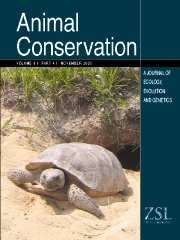Crossref Citations
This article has been cited by the following publications. This list is generated based on data provided by
Crossref.
Lee, Jonathan S. F.
Waldman, Bruce
and
Gatten Jr., R. E.
2002.
Communication by Fecal Chemosignals in an Archaic Frog, Leiopelma hamiltoni.
Copeia,
Vol. 2002,
Issue. 3,
p.
679.
Hay, Jennifer M
Daugherty, Charles H
Cree, Alison
and
Maxson, Linda R
2003.
Low genetic divergence obscures phylogeny among populations of Sphenodon, remnant of an ancient reptile lineage.
Molecular Phylogenetics and Evolution,
Vol. 29,
Issue. 1,
p.
1.
Bell, Ben D.
Pledger, Shirley
and
Dewhurst, Paulette L.
2004.
The fate of a population of the endemic frogLeiopelma pakeka(Anura: Leiopelmatidae) translocated to restored habitat on Maud Island, New Zealand.
New Zealand Journal of Zoology,
Vol. 31,
Issue. 2,
p.
123.
Berry, Oliver
and
Gleeson, Dianne M.
2005.
Distinguishing historical fragmentation from a recent population decline – shrinking or pre-shrunk skink from New Zealand?.
Biological Conservation,
Vol. 123,
Issue. 2,
p.
197.
Baber, Matthew
Moulton, Heather
Smuts‐Kennedy, Chris
Gemmell, Neil
and
Crossland, Michael
2006.
Discovery and spatial assessment of a Hochstetter's frog(Leiopelma hochstetteri)population found in Maungatautari Scenic Reserve, New Zealand.
New Zealand Journal of Zoology,
Vol. 33,
Issue. 2,
p.
147.
Taylor, S. S.
Jamieson, I. G.
and
Wallis, G. P.
2007.
Historic and contemporary levels of genetic variation in two New Zealand passerines with different histories of decline.
Journal of Evolutionary Biology,
Vol. 20,
Issue. 5,
p.
2035.
French, NP
Gemmell, NJ
and
Buddle, BM
2007.
Advances in biosecurity to 2010 and beyond: Towards integrated detection, analysis and response to exotic pest invasions.
New Zealand Veterinary Journal,
Vol. 55,
Issue. 6,
p.
255.
APTE, S.
SMITH, P. J.
and
WALLIS, G. P.
2007.
Mitochondrial phylogeography of New Zealand freshwater crayfishes, Paranephrops spp..
Molecular Ecology,
Vol. 16,
Issue. 9,
p.
1897.
LIGGINS, LIBBY
CHAPPLE, DAVID G.
DAUGHERTY, CHARLES H.
and
RITCHIE, PETER A.
2008.
A SINE of restricted gene flow across the Alpine Fault: phylogeography of the New Zealand common skink (Oligosoma nigriplantare polychroma).
Molecular Ecology,
Vol. 17,
Issue. 16,
p.
3668.
WALLIS, GRAHAM P.
and
TREWICK, STEVEN A.
2009.
New Zealand phylogeography: evolution on a small continent.
Molecular Ecology,
Vol. 18,
Issue. 17,
p.
3548.
BELL, BEN D.
and
PLEDGER, SHIRLEY A.
2010.
How has the remnant population of the threatened frogLeiopelma pakeka(Anura: Leiopelmatidae) fared on Maud Island, New Zealand, over the past 25 years?.
Austral Ecology,
Vol. 35,
Issue. 3,
p.
241.
Fouquet, Antoine
Green, David M.
Waldman, Bruce
Bowsher, Julia H.
McBride, Katherine P.
and
Gemmell, Neil J.
2010.
Phylogeography of Leiopelma hochstetteri reveals strong genetic structure and suggests new conservation priorities.
Conservation Genetics,
Vol. 11,
Issue. 3,
p.
907.
Newman, Donald G
Bell, Ben D
Bishop, Phillip J
Burns, Rhys
Haigh, Amanda
Hitchmough, Rodney A
and
Tocher, Mandy
2010.
Conservation status of New Zealand frogs, 2009.
New Zealand Journal of Zoology,
Vol. 37,
Issue. 2,
p.
121.
Fouquet, Antoine
Ficetola, Gentile Francesco
Haigh, Amanda
and
Gemmell, Neil
2010.
Using ecological niche modelling to infer past, present and future environmental suitability for Leiopelma hochstetteri, an endangered New Zealand native frog.
Biological Conservation,
Vol. 143,
Issue. 6,
p.
1375.
Carver, Scott
Bell, Ben D.
and
Waldman, Bruce
2010.
Does Chytridiomycosis Disrupt Amphibian Skin Function?.
Copeia,
Vol. 2010,
Issue. 3,
p.
487.
Shaw, Stephanie
Speare, Richard
Lynn, Denis H
Yeates, Gregor
Zhao, Zeng
Berger, Lee
and
Jakob-Hoff, Richard
2011.
Nematode and Ciliate Nasal Infection in Captive Archey's Frogs (Leiopelma archeyi).
Journal of Zoo and Wildlife Medicine,
Vol. 42,
Issue. 3,
p.
473.
Zavodna, Monika
Grueber, Catherine E.
Gemmell, Neil J.
and
Sunnucks, Paul
2013.
Parallel Tagged Next-Generation Sequencing on Pooled Samples – A New Approach for Population Genetics in Ecology and Conservation.
PLoS ONE,
Vol. 8,
Issue. 4,
p.
e61471.
Ohmer, M. E.
Herbert, S. M.
Speare, R.
and
Bishop, P. J.
2013.
Experimental exposure indicates the amphibian chytrid pathogen poses low risk to New Zealand's threatened endemic frogs.
Animal Conservation,
Vol. 16,
Issue. 4,
p.
422.
Worthy, TH
Tennyson, AJD
Scofield, RP
and
Hand, SJ
2013.
Early Miocene fossil frogs (Anura: Leiopelmatidae) from New Zealand.
Journal of the Royal Society of New Zealand,
Vol. 43,
Issue. 4,
p.
211.
Reilly, Stephen
Essner, Richard
Wren, Sally
Easton, Luke
and
Bishop, Phillip J.
2015.
Movement patterns in leiopelmatid frogs: Insights into the locomotor repertoire of basal anurans.
Behavioural Processes,
Vol. 121,
Issue. ,
p.
43.

